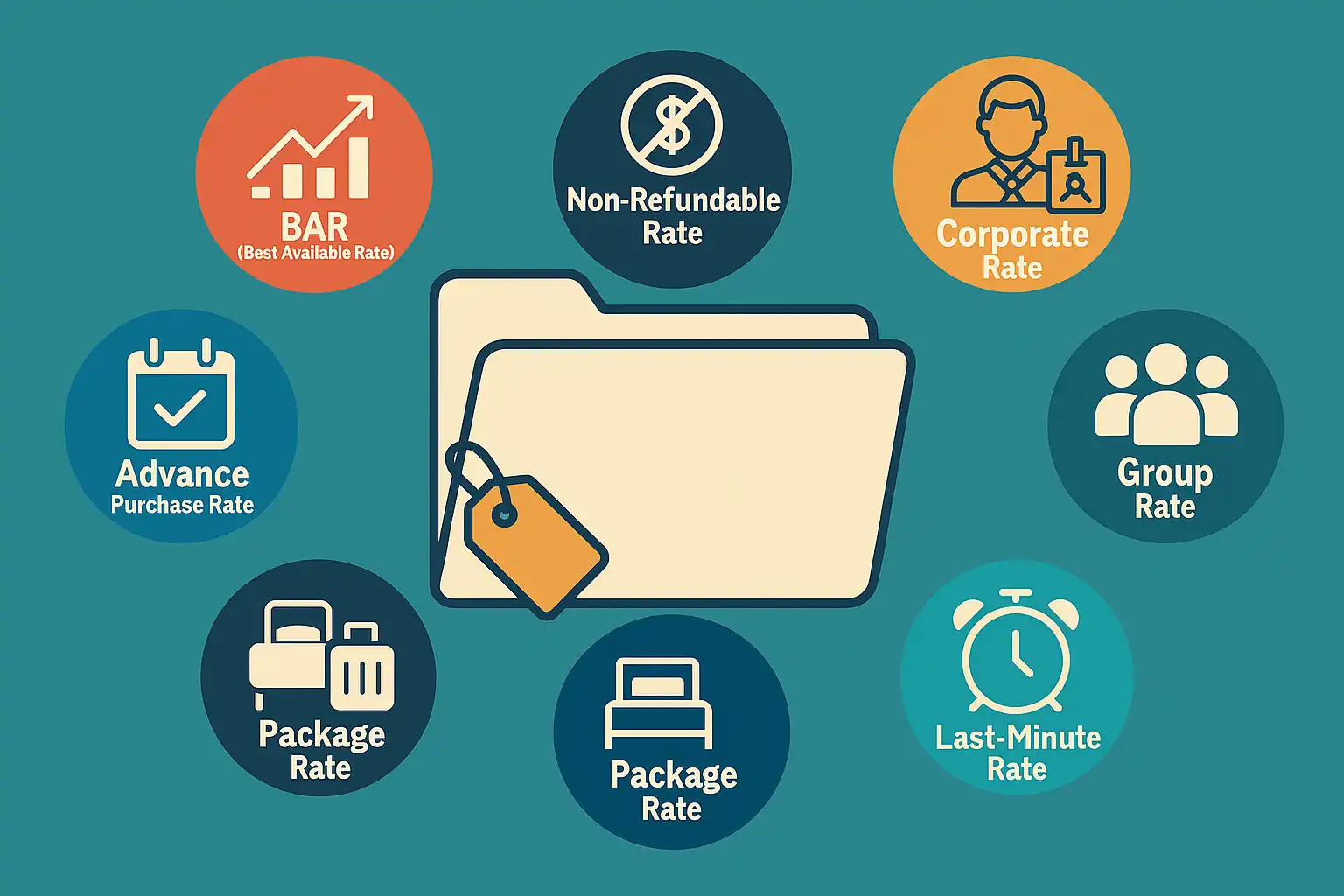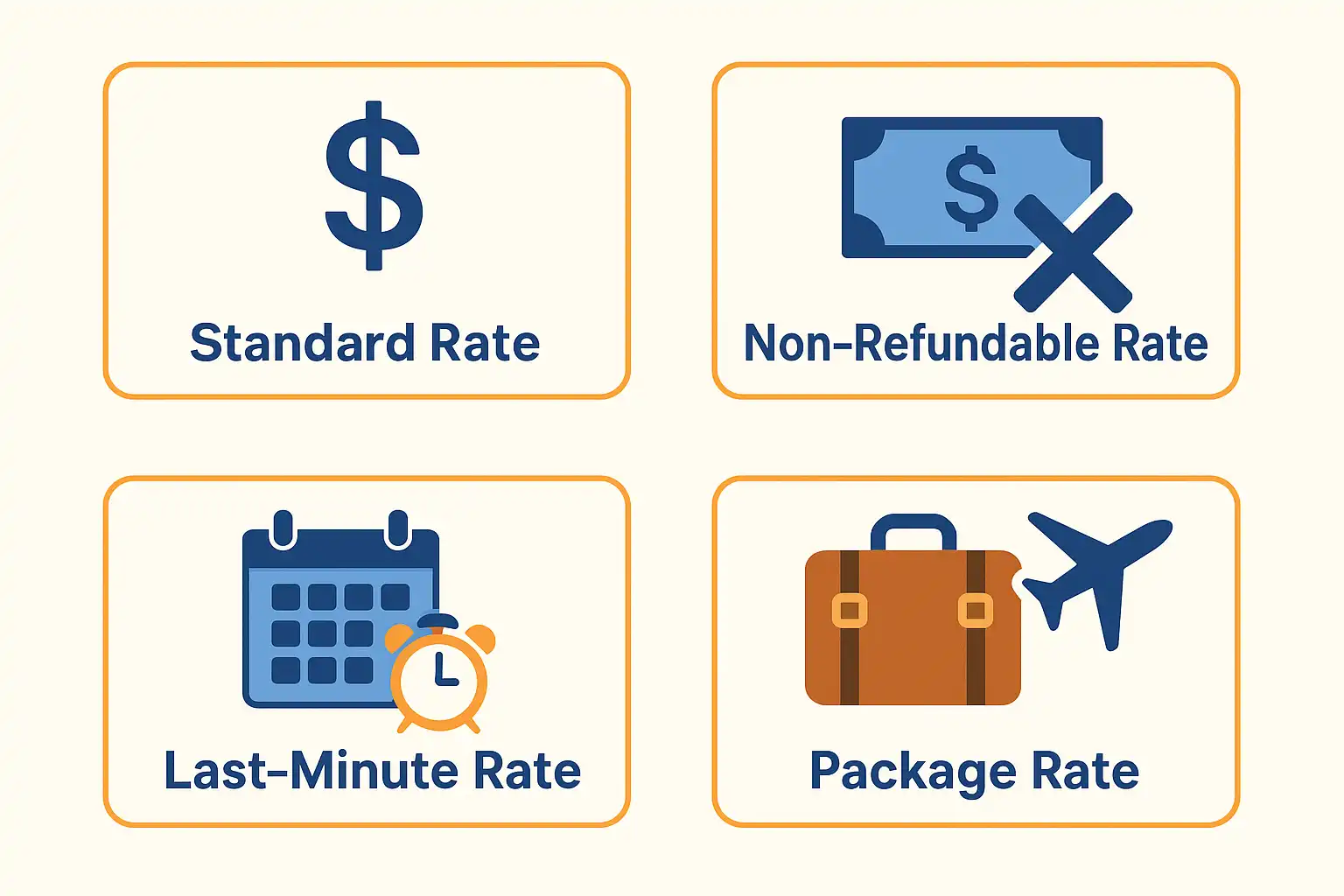Most Important Hotel Rate Types and How to Use Them
 Mika Takahashi
Mika Takahashi Mika Takahashi
Mika TakahashiIn today’s fast-paced and competitive hospitality industry, relying on just one pricing strategy means missing out on a lot of potential revenue. With the average daily rate expected to grow by 1.6% in 2025, savvy hotels are turning to a variety of hotel rate types to attract different kinds of guests and make the most of their revenue opportunities.
Hotel rate types are essentially different pricing categories that hotels use to appeal to various guest segments while boosting occupancy rates and revenue per available room (RevPAR). Whether it’s business travelers looking for flexible booking options or leisure guests hunting for the best deal, each group has unique needs—and using the right hotel room rates helps meet those needs effectively.
Having a mix of hotel rate types brings clear advantages. Hotels can fill rooms during slow times, increase revenue when demand is high, and reduce their reliance on costly distribution channels. Plus, well-crafted rate plans encourage more direct bookings, which can save hotels 15-25% in commission fees usually paid to online travel agencies.
This guide dives into the most important hotel rate types, how to use them smartly, and the technology tools revenue managers rely on to maximize room revenue—all while staying competitive in a constantly changing market.

Hotel rate types are structured pricing options designed to cater to different guest groups based on booking terms, flexibility, and included perks. Instead of offering just one room rate, hotels create a range of pricing choices that fit diverse traveler preferences and help optimize revenue across varying market conditions.
Why does this matter? Because when demand outweighs supply, hotels can charge premium rates to guests willing to pay for flexibility or last-minute bookings. And during slower periods, discounted hotel rate types help guarantee steady revenue and keep occupancy up without undermining long-term pricing.
Research shows that hotels using a well-rounded mix of hotel rate types see significant boosts in key metrics. Properties embracing dynamic pricing and multiple rate categories often report 5-20% higher RevPAR compared to those sticking with static pricing. This success comes from better market positioning, sharper guest segmentation, and smarter management of distribution channels.
Direct bookings benefit the most. Hotels that offer exclusive rates through their own websites—like member-only deals or special packages not found on third-party sites—can attract guests away from commission-heavy channels. This not only improves profit margins but also gives hotels valuable guest data for future marketing efforts.
For revenue managers, having a variety of hotel room rates means the flexibility to quickly adapt to market shifts. Whether reacting to local events, competing hotels, or peak demand, multiple hotel rate types are essential tools in their revenue management toolkit.
The rack rate is the backbone of any hotel’s pricing strategy. It’s the highest published rate for a room without any discounts or special offers. While it used to be shown on physical rate cards, today the rack rate acts as a pricing anchor that helps position the hotel within the competitive landscape.
Rack rates vary widely depending on property type and location. Budget hotels might set rack rates between $80-120 per night, while luxury hotels in prime locations can charge $400-800 or more. The trick is setting a rack rate that matches the hotel’s value while leaving room for discount pricing strategies.
Modern revenue management systems use rack rates as a baseline, with other hotel rate types positioned as percentages below it. This keeps pricing consistent and prevents unnecessary discounting during busy times when hotels could otherwise charge more.
To set competitive rack rates in 2025, revenue managers should regularly analyze competitors, review rates annually based on property upgrades, and align with brand standards if franchised. Tracking occupancy and average daily rate at full rack rate helps ensure these premium prices capture value during peak demand.
The Best Available Rate, or BAR, is the lowest publicly available rate for a specific date and room type, and it’s central to dynamic pricing strategies. Unlike fixed rack rates, BAR fluctuates based on occupancy, market demand, and competitor pricing.
Typically, BAR sits 10-30% below rack rate depending on market conditions and how far out the booking is made. During slower times, hotels might offer BAR at deep discounts to attract budget-conscious guests. When demand is high, BAR inches closer to rack rate, allowing hotels to maximize revenue from remaining rooms.
Revenue management systems automate BAR adjustments using data from past bookings, competitor rates, and local events. These algorithms can update prices multiple times a day to keep hotels competitive and profitable.
For example, a boutique hotel might start BAR at 20% below rack rate for bookings 90 days ahead, then raise it to within 5% of rack rate as the date approaches and rooms fill up. This encourages early bookings while preserving the ability to charge premium rates last-minute.
Non-refundable rates offer guests a discount of 5-15% off standard prices in exchange for upfront payment and a commitment to their reservation. This hotel rate type guarantees revenue for hotels and appeals to travelers who prioritize savings over flexibility.
Guests pay in full when booking and face strict cancellation policies. Hotels benefit from better cash flow, fewer cancellations, and more reliable demand forecasts. For travelers, especially leisure guests with fixed plans, the trade-off between savings and flexibility is often worth it.
Clear communication is key. Hotels should make cancellation policies obvious during booking and in confirmation emails to avoid misunderstandings and disputes.
Business travelers with confirmed schedules and leisure travelers planning well in advance are prime candidates for non-refundable rates. The discount needs to be attractive enough—usually 8-12%—to encourage bookings without undercutting flexible rate revenue.
Early bird or advance purchase rates reward guests who book well ahead—typically 30 to 180 days in advance—with discounts of 10-25% off BAR. These hotel rate types help hotels secure committed revenue during uncertain booking windows and improve cash flow.
Early bookings give revenue managers better insight into future demand, helping with staffing and operational planning. Hotels can adjust marketing and inventory based on early booking trends.
These rates work especially well during peak seasons. For example, summer 2025 advance purchase rates offered in winter can lock in a base level of occupancy before the busy booking period kicks in.
Pairing advance purchase rates with loyalty programs boosts effectiveness. Hotels might offer 15% off general early bookings but 20% off for loyalty members, encouraging both early commitment and repeat business.
The challenge is balancing discounts with cancellation policies. Most successful programs allow modifications with fees rather than outright bans on cancellations to keep bookings attractive.
Package and bundle rates combine rooms with extras like meals or local attractions, offering guests more value while boosting revenue per booking by 30-40%.
Breakfast-included packages remain popular, with continental breakfasts adding $15-25 per night and full breakfasts $25-40 premiums. Guests love the convenience and perceive bundled deals as better value—even if individual components might cost less separately.
Local attraction packages are a goldmine for hotels in tourist hotspots. Ski passes, spa treatments, or concert tickets bundled with stays create unique offers that justify higher prices and increase total spend.
Corporate packages that include meeting rooms, catering, and business services can command premium prices while simplifying event planning.
The key to success is understanding guest preferences and local opportunities. Analyze what guests buy separately and bundle those items to increase transaction values without sacrificing perceived value.
Group and corporate rates target bookings of 10 or more rooms, offering 15-30% discounts to secure volume business. These hotel rate types bring predictable revenue and foster long-term relationships with key accounts.
Corporate negotiated rates form the backbone of business travel revenue. Annual contracts lock in rates for frequent travelers, benefiting both companies and hotels by providing cost predictability and steady occupancy.
Government and military rates, though requiring verification, tap into large travel volumes near bases or offices, often aligned with federal per diem rates.
Event-based group rates for conferences or weddings require careful negotiation to protect overall revenue. While room rates might be discounted, additional revenue from catering and meeting spaces often offsets lower margins.
Smart contract terms like attrition clauses and flexible pricing during peak times ensure group rates support, rather than hurt, overall revenue goals.

Last-minute and walk-in rates help fill unsold rooms by offering 20-40% discounts for same-day or next-day bookings. These tactical hotel rate types maximize occupancy while minimizing revenue loss from empty rooms.
Mobile app-exclusive rates have become popular for spontaneous travelers, encouraging direct bookings and appealing especially to younger guests who prefer booking on their phones.
Front desk staff need training to quote competitive last-minute prices while maximizing revenue. Hotels in busy areas often see walk-in spikes during events or travel disruptions.
Revenue management systems can automate last-minute rate triggers based on occupancy thresholds—like dropping prices when same-day occupancy falls below 70%.
The trick is to avoid training guests to always wait for discounts. Maintaining rate integrity during high-demand times and limiting last-minute deals to truly distressed inventory helps preserve revenue.
Length of stay rates include minimum stay requirements during busy times and discounts for longer stays. These hotel rate types optimize revenue by controlling booking patterns and encouraging guests to stay longer.
Minimum stays of 3-7 nights during peak periods prevent short bookings that block more profitable longer stays. Weekend minimum stays in resorts ensure full weekend revenue capture.
Extended stay discounts appeal to corporate relocations and long-term travelers, offering 10-20% off for stays of 7+ nights, with deeper discounts for monthly bookings. Lower operational costs for longer stays justify these savings.
Shoulder season promotions like “stay 3 nights, get the 4th free” encourage longer visits without undercutting nightly rates.
Longer stays also reduce housekeeping and front desk workload, lower wear and tear, and create better guest relationships that drive loyalty.
Post-pandemic, guests expect more booking flexibility. Hotels now offer a range of cancellation policies to match different risk tolerances.
Free cancellation rates command 10-20% premiums and appeal to guests valuing the peace of mind to change plans penalty-free. These rates are especially popular for leisure travelers and uncertain business trips.
Restricted rates with change fees and cancellation penalties offer moderate discounts while protecting revenue. Typical fees range from $50-75, with penalties increasing closer to arrival.
Hotels have introduced “book now, decide later” rates allowing free cancellation up to 24-48 hours before arrival, capturing hesitant travelers while safeguarding revenue.
Balancing guest satisfaction and revenue protection is key. Graduated penalty structures encourage early bookings and reduce last-minute cancellations that hurt resale chances.
To succeed with hotel rate types, properties need property management systems (PMS) that handle multiple rate categories across all booking channels. Modern PMS must support complex pricing while maintaining parity and avoiding booking mistakes.
Channel managers help distribute rates consistently across OTAs, global distribution systems, and direct channels. Revenue managers set rules to prevent rate undercutting while allowing tactical adjustments based on market and inventory.
Top revenue management software like IDeaS, Duetto, and RevPar Guru automate rate optimization using demand forecasts, competitor data, and historical trends. These tools can manage dozens of hotel rate types simultaneously while keeping pricing relationships optimal.
Real-time rate adjustments based on occupancy—like bumping prices when occupancy passes 85% or triggering last-minute discounts when rooms remain empty—help hotels respond quickly to market changes.
Close coordination between revenue management systems and distribution channels is essential to maintain rate integrity. Regular audits ensure rates display correctly and bookings flow smoothly, protecting revenue and guest trust.
Weekly competitor rate shopping is vital for optimizing hotel rate types. Revenue managers track competitor pricing across all categories to spot chances to gain market share or capitalize on weaknesses.
Developing seasonal rate calendars based on historical data, market forecasts, and upcoming events lets hotels plan rate strategies proactively instead of reacting last minute.
Analyzing how local events impact demand helps target hotel rate types effectively. Sporting events might boost corporate rates, while festivals increase package bookings.
Benchmarking with STR data validates rate strategies against similar hotels, highlighting areas for improvement.
Competitive analysis goes beyond price comparisons. Hotels must evaluate how their rate types stack up on amenities, cancellation policies, and overall guest value to truly compete.
AI-powered revenue management tools now predict demand with over 95% accuracy, allowing precise optimization of hotel rate types under changing market conditions. These systems analyze millions of data points—booking patterns, events, weather, economy—to forecast demand like never before.
Automated rate adjustments respond instantly to competitor price changes and market shifts. When a competitor lowers rates, hotels can react within minutes to maintain their competitive edge without manual effort.
Integration with booking engines enhances rate type presentation and upselling throughout the guest journey. Smart algorithms show the best rate options based on guest behavior, booking history, and market trends, boosting conversions and average spend.
Mobile-first booking platforms support sophisticated rate selection, guiding guests to the best choices and highlighting savings or upgrades that increase revenue and satisfaction.
The blend of AI and revenue management is evolving rapidly, with predictive analytics enabling hotels to strategically deploy hotel rate types weeks or months ahead to maximize revenue during peak demand.
Limit website rate displays to 3-5 main hotel rate types to avoid overwhelming guests. Too many options cause choice paralysis and reduce bookings, while too few limit revenue potential.
Use clear, simple language to describe rate terms, cancellation policies, and benefits. Avoid jargon so guests understand exactly what they’re getting, building trust and reducing disputes.
Order rates strategically to nudge guests toward higher-value bookings. For example, placing a moderately priced flexible rate between a restrictive discount and a premium package makes the middle option more appealing.
A/B test how rates are presented—layouts, descriptions, pricing—to learn what converts best for different guest groups.
Communicate clearly beyond booking—confirmation emails, pre-arrival messages, and check-in instructions should reinforce what guests purchased and how to manage their reservations.
Track key metrics like average daily rate by hotel rate type, conversion rates, booking lead times, and revenue share weekly. Use this data to fine-tune pricing and marketing.
Review rate performance monthly to identify which types exceed or miss expectations. Analyze market factors influencing results and adjust strategies accordingly.
Guest feedback on booking experience, price perception, and likelihood to rebook helps complement data insights.
Annual strategic reviews should incorporate market changes, property upgrades, and competitive shifts to keep rate offerings fresh and effective.
Continuous optimization based on market signals, guest behavior, and operational results is essential. Hotels that regularly update their hotel rate types outperform those stuck with static pricing.
The hospitality industry’s move toward sophisticated hotel rate types reflects guests’ growing expectations for choice and value. Hotels mastering these strategies gain a strong competitive edge through better revenue, happier guests, and stronger market position.
Revenue optimization through well-planned hotel rate types is both an art and a science, blending data, intuition, and operational skill. As the market evolves, hotels investing in diverse rate strategies will be best prepared for long-term success.
For those just starting out, focus first on core hotel rate types—rack rate, Best Available Rate, and non-refundable options—before expanding into more complex promotional and dynamic pricing. This builds expertise and guest confidence in your pricing.
Looking ahead, the future of hotel pricing is personalization, flexibility, and data-driven decisions. Hotels embracing comprehensive hotel rate types today will be ready to meet tomorrow’s challenges while maximizing revenue across all guest segments and market conditions.